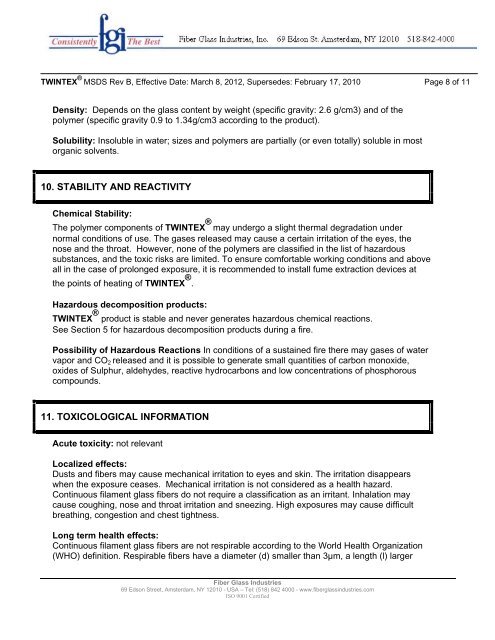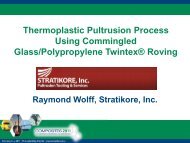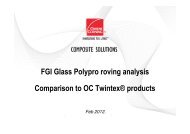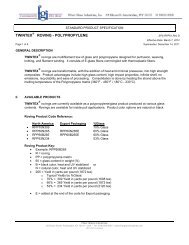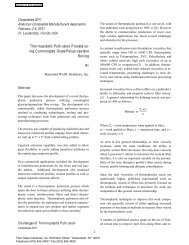Twintex® MSDS - Fiber Glass Industries, Inc
Twintex® MSDS - Fiber Glass Industries, Inc
Twintex® MSDS - Fiber Glass Industries, Inc
Create successful ePaper yourself
Turn your PDF publications into a flip-book with our unique Google optimized e-Paper software.
TWINTEX ® <strong>MSDS</strong> Rev B, Effective Date: March 8, 2012, Supersedes: February 17, 2010 Page 8 of 11<br />
Density: Depends on the glass content by weight (specific gravity: 2.6 g/cm3) and of the<br />
polymer (specific gravity 0.9 to 1.34g/cm3 according to the product).<br />
Solubility: Insoluble in water; sizes and polymers are partially (or even totally) soluble in most<br />
organic solvents.<br />
10. STABILITY AND REACTIVITY<br />
Chemical Stability:<br />
The polymer components of TWINTEX ® may undergo a slight thermal degradation under<br />
normal conditions of use. The gases released may cause a certain irritation of the eyes, the<br />
nose and the throat. However, none of the polymers are classified in the list of hazardous<br />
substances, and the toxic risks are limited. To ensure comfortable working conditions and above<br />
all in the case of prolonged exposure, it is recommended to install fume extraction devices at<br />
the points of heating of TWINTEX ® .<br />
Hazardous decomposition products:<br />
TWINTEX ® product is stable and never generates hazardous chemical reactions.<br />
See Section 5 for hazardous decomposition products during a fire.<br />
Possibility of Hazardous Reactions In conditions of a sustained fire there may gases of water<br />
vapor and CO2 released and it is possible to generate small quantities of carbon monoxide,<br />
oxides of Sulphur, aldehydes, reactive hydrocarbons and low concentrations of phosphorous<br />
compounds.<br />
11. TOXICOLOGICAL INFORMATION<br />
Acute toxicity: not relevant<br />
Localized effects:<br />
Dusts and fibers may cause mechanical irritation to eyes and skin. The irritation disappears<br />
when the exposure ceases. Mechanical irritation is not considered as a health hazard.<br />
Continuous filament glass fibers do not require a classification as an irritant. Inhalation may<br />
cause coughing, nose and throat irritation and sneezing. High exposures may cause difficult<br />
breathing, congestion and chest tightness.<br />
Long term health effects:<br />
Continuous filament glass fibers are not respirable according to the World Health Organization<br />
(WHO) definition. Respirable fibers have a diameter (d) smaller than 3µm, a length (l) larger<br />
<strong>Fiber</strong> <strong>Glass</strong> <strong>Industries</strong><br />
69 Edson Street, Amsterdam, NY 12010 - USA – Tel: (518) 842 4000 - www.fiberglassindustries.com<br />
ISO 9001 Certified


